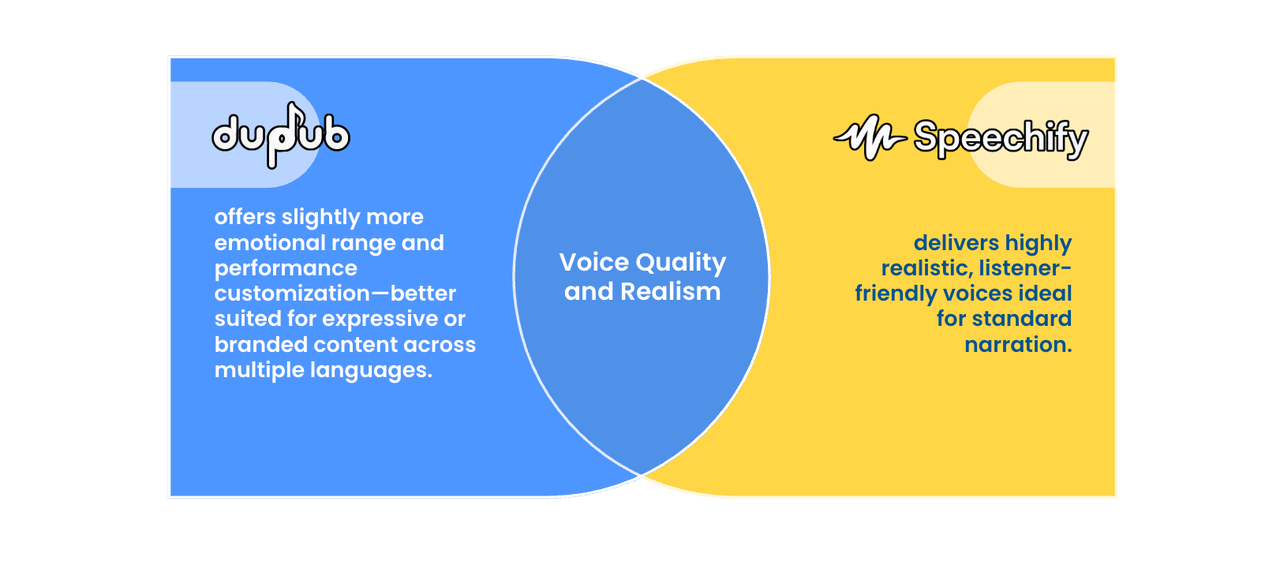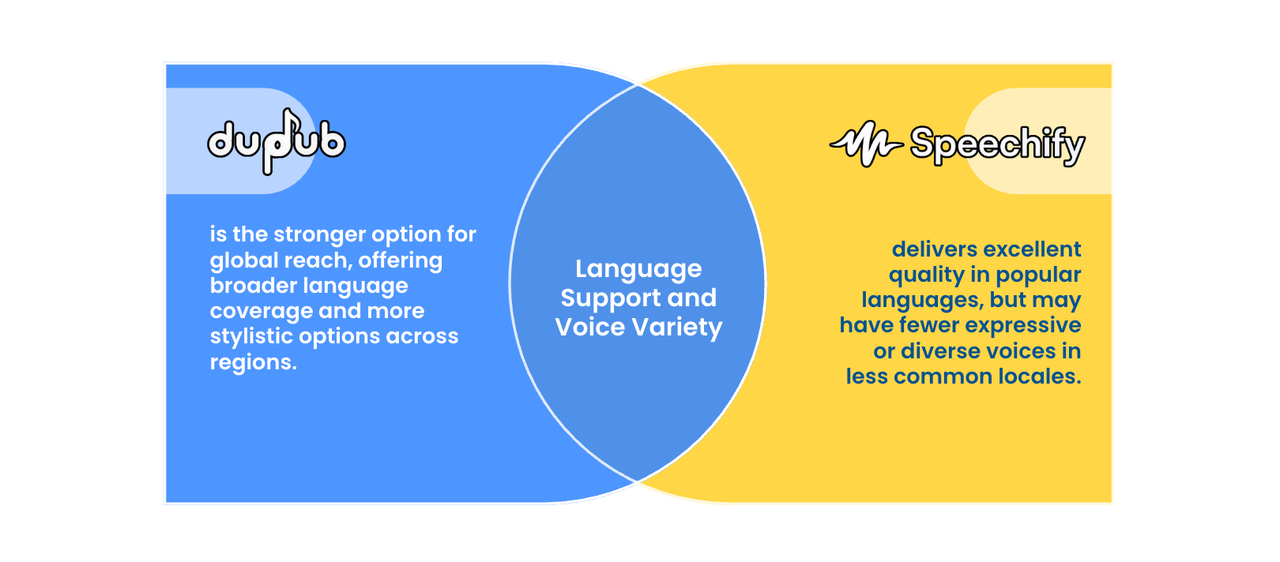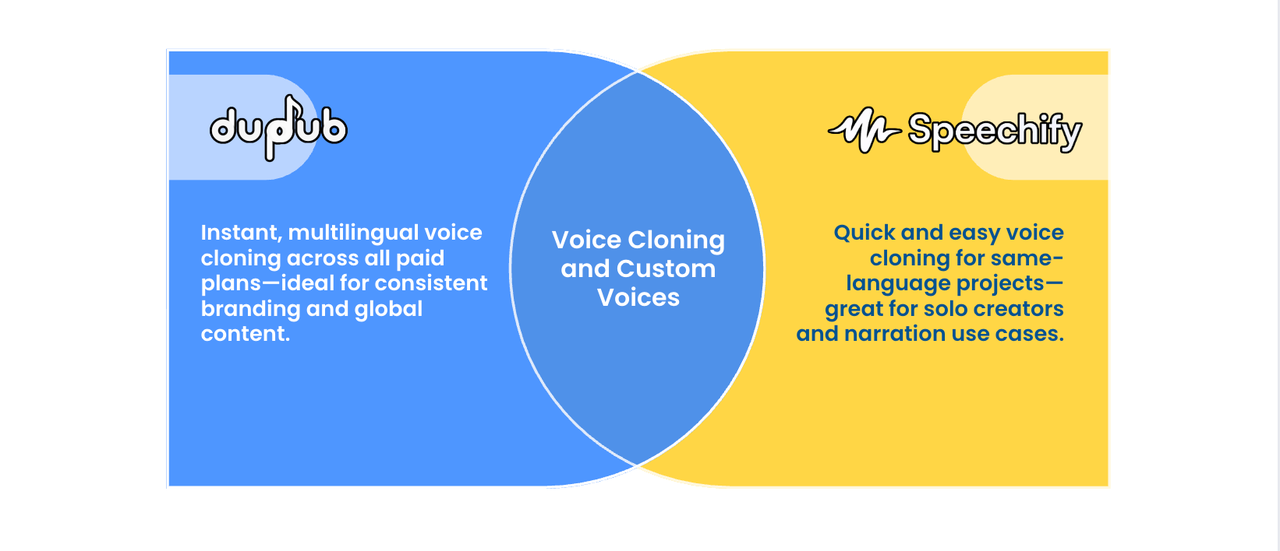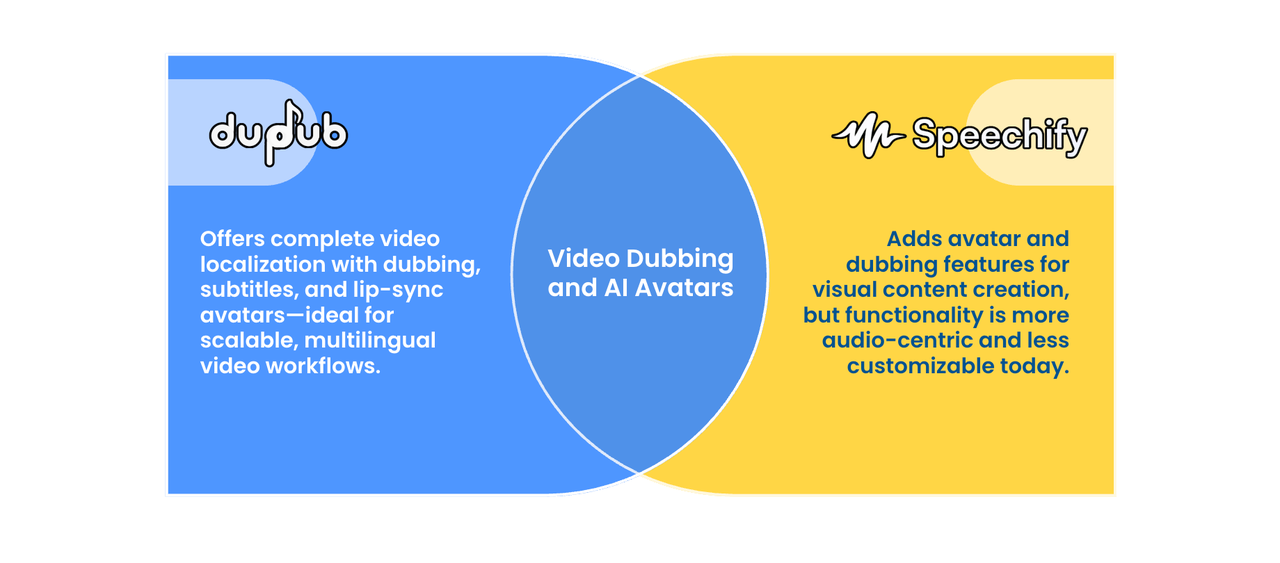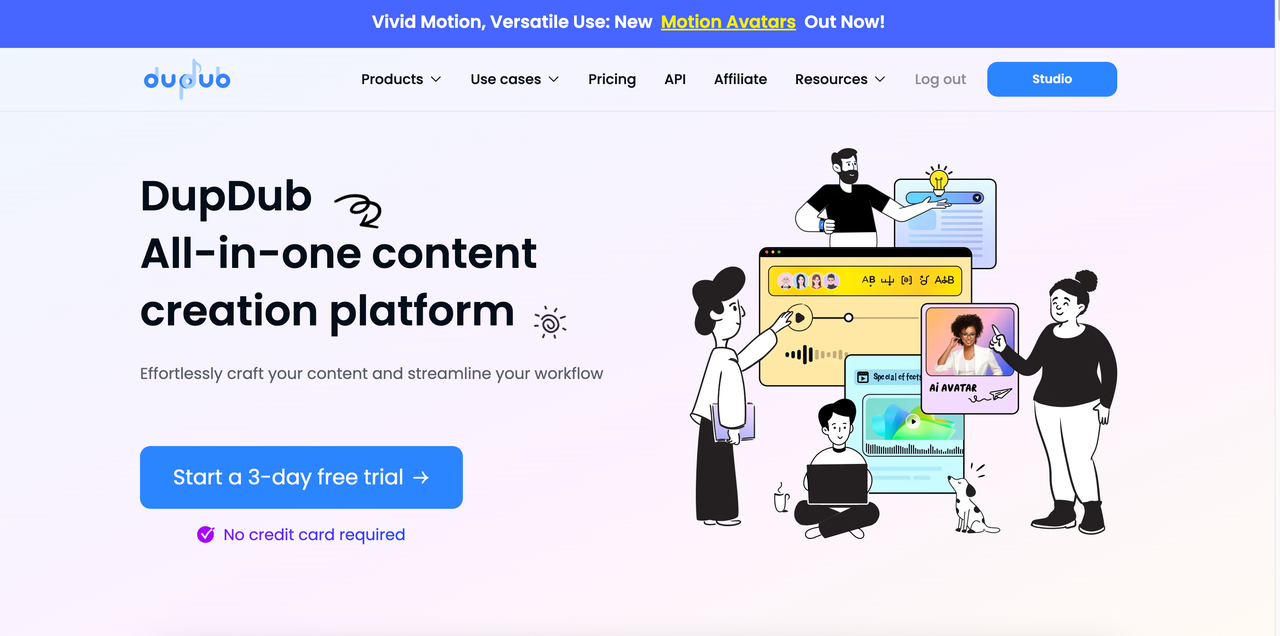In the fast-growing world of AI voice generation, creators in 2025 have more powerful tools than ever before. Whether you're dubbing videos, narrating content, localizing for global audiences, or automating workflows—AI voice platforms are now full-fledged creative engines.
Two of the most talked-about platforms are DupDub and Speechify. DupDub positions itself as an all-in-one multimedia creation suite, offering everything from voiceovers to video dubbing to AI avatars. Speechify, on the other hand, started as a smart reading tool and has expanded into a sleek, voice-focused creative platform known for its simplicity and ultra-realistic voices.
While both can turn text into highly natural speech, they differ significantly in workflow, language support, pricing, and advanced capabilities. In this in-depth comparison, we’ll break down their features, pricing models, and use cases to help you decide which tool is the right fit for your creative goals.
Quick Comparison Table: DupDub vs Speechify
| Aspect |
DupDub |
Speechify |
| Voice Quality |
Expressive, emotional, natural |
Ultra-realistic, clear, engaging |
| Language Support |
90+ languages and accents |
60+ languages |
| Voice Library |
700+ curated voices with 1,000+ styles |
1,000+ voices (mostly focused on English) |
| Voice Cloning |
Yes (instant, multilingual, all paid plans) |
Yes (Studio only; mainly mono-language) |
| Video Features |
Yes – dubbing, avatars, lip-sync, subtitles |
Yes – basic dubbing and avatars (Studio only) |
| Free Tier |
3-day Pro trial (10 credits) |
Free plan – 10 standard voices, basic playback |
| Paid Plans & Pricing |
Personal: $11/mo (~2 hrs)
Professional: $30/mo (~7 hrs)
Ultimate: $110/mo (~34 hrs) |
Premium: $11.58/mo (annual)
API & Avatars: Contact sales |
| API Access |
Yes (from Personal Plan) |
Not publicly available – API in waitlist stage |
| Best For |
Multilingual, video-integrated content creation |
Audio narration, text reading, fast voiceover tasks |
Voice Quality and Realism
When it comes to how natural the generated voices sound, both DupDub and Speechify offer impressive results—though they approach voice design from different angles.
Speechify focuses heavily on creating ultra-realistic, lifelike voices, particularly for English and major global languages. Its voice library includes professionally tuned tones that sound clear, smooth, and natural to the ear. These voices are ideal for reading long-form content like articles, scripts, or audiobooks, where listener comfort and clarity are essential. Speechify also includes well-known or “celebrity” voices in some plans, which adds extra appeal for casual or branded content. In short, Speechify emphasizes realism and fluidity in standard narration scenarios.
DupDub, while equally strong in naturalness, leans into expressiveness and emotional depth. Its voice catalog offers over 1,000 styles—ranging from joyful and energetic to serious and dramatic—across many languages. This makes DupDub particularly effective for storytelling, character-driven scripts, or marketing content where tone matters. Whether you need an authoritative speaker or a soft, friendly explainer, DupDub gives you a wide emotional palette to choose from. Additionally, voices in DupDub can be adjusted for pitch, speed, and pause control, offering more creative flexibility in performance.
Summary:
-
Speechify delivers highly realistic, listener-friendly voices ideal for standard narration.
-
DupDub offers slightly more emotional range and performance customization—better suited for expressive or branded content across multiple languages.
Language Support and Voice Variety
Multilingual capability is a major factor when choosing a voice platform—especially for global brands, educators, or creators targeting diverse regions.
DupDub offers support for over 90 languages and accents, covering not just widely spoken languages like English, Spanish, and Chinese, but also a long tail of underrepresented ones—such as Swahili, Mongolian, Welsh, and Javanese. This breadth makes it ideal for localization, international marketing, or cross-border content creation. In addition to sheer language count, DupDub provides multiple voice options per language, including gender variety and stylistic choices. This ensures consistent tone and quality even across different regions or target audiences.
Speechify, meanwhile, supports 60+ languages, which includes all major global languages as well as regional variants like British vs American English, or Castilian vs Latin American Spanish. The platform offers 1,000+ voices, but many of these are concentrated in English and other widely used languages. For most users, the available voices in non-English regions are fewer in variety, but still sufficient for basic narration or reading tasks. The voice quality remains high, though expressive range per language may vary.
Summary:
-
DupDub is the stronger option for global reach, offering broader language coverage and more stylistic options across regions.
-
Speechify delivers excellent quality in popular languages, but may have fewer expressive or diverse voices in less common locales.
Voice Cloning and Custom Voices
AI voice cloning has become an essential tool for modern content creators. Whether replicating your own voice for consistency or building custom characters for narration, this feature can drastically reduce production time while maintaining authenticity.
DupDub offers instant voice cloning across all paid plans—including the entry-level Personal plan. With just a short audio sample, users can generate a digital replica of any voice and begin using it within minutes. A key advantage of DupDub’s cloning system is its multilingual capability—your cloned voice can speak in up to 47 languages while preserving the tone and vocal identity. This is a standout feature for creators producing international content or operating in multiple markets under a single brand voice.
Speechify also supports custom voice cloning, available through its Studio platform. The setup process is fast and user-friendly—requiring as little as 20 seconds of recorded audio to generate a usable voice clone. This low barrier to entry is excellent for beginners or solo creators. However, Speechify’s cloned voices are generally language-specific and currently focus on same-language output. Multilingual output with the same cloned voice is not its primary use case. Additionally, cloned voices in Speechify are primarily geared toward reading and basic voiceover, without deep integration into multi-format workflows like dubbing or avatar speech.
Summary:
-
DupDub: Instant, multilingual voice cloning across all paid plans—ideal for consistent branding and global content.
-
Speechify: Quick and easy voice cloning for same-language projects—great for solo creators and narration use cases.
Video Dubbing and AI Avatars
Modern content creation is no longer just about audio—video dubbing and on-screen avatars are becoming vital for reaching audiences across platforms, languages, and formats.
DupDub offers a fully integrated video pipeline. You can upload any video with spoken content, and DupDub will transcribe, translate, and generate a new voiceover in your selected language. Even better, it supports automatic subtitle generation and lip-sync alignment, so the dubbed voice matches the speaker’s mouth movements. This makes it particularly powerful for YouTube creators, educators, and global marketing teams looking to repurpose video content across languages.
Beyond dubbing, DupDub also enables AI avatar video generation. Users can choose from preset avatars or upload a photo to generate a talking-head style presenter. This avatar can speak your script in any supported language, with synchronized lip movement and customizable style (pose, clothing, etc.). The ability to generate video, voice, and subtitles in one place makes DupDub a true multimedia studio.
Speechify, originally focused on audio, has more recently expanded into video features through Speechify Studio. It now supports AI dubbing in over 60 languages—allowing users to upload content and produce localized versions using its wide voice library. However, dubbing is currently audio-focused, and there is less control over visual timing, subtitles, or lip-sync compared to DupDub.
Speechify has also introduced AI avatars, offering a library of preset characters that can be used to deliver spoken content visually. While this is a welcome addition, customization and avatar realism appear to be more limited at this stage, and fine control over avatar behavior is still evolving. These features are promising, but they may require a Studio or enterprise-tier setup to unlock their full potential.
Summary:
-
DupDub: Offers complete video localization with dubbing, subtitles, and lip-sync avatars—ideal for scalable, multilingual video workflows.
-
Speechify: Adds avatar and dubbing features for visual content creation, but functionality is more audio-centric and less customizable today.
Usability and Platform Integration
A powerful tool means little if it’s hard to use. User experience—how intuitive, flexible, and accessible a platform is—plays a key role in adoption and workflow efficiency.
DupDub is designed as an all-in-one creative suite. It’s web-based, and while the interface is clean, the depth of functionality means there’s a moderate learning curve—especially for users new to dubbing or avatar-based content. DupDub operates on a credit-based system: each voice generation, video, or translation task consumes credits depending on the complexity or quality level. This system offers flexibility, letting you allocate usage between voice, video, and other features as needed—but it may take time to understand what each action costs.
That said, once familiar, creators benefit from centralized workflow—voiceovers, subtitles, translations, and avatars are all handled in one environment. DupDub also supports API access (starting with the Professional plan), which enables integration into automated pipelines or developer tools. For teams or creators managing volume production, this makes DupDub highly adaptable.
Speechify, on the other hand, is built with simplicity and speed in mind. Its user interface is streamlined and beginner-friendly, with minimal setup required. Originally designed for reading and productivity, Speechify's apps—available on web, iOS, Android, and browser extensions—let users generate and preview content across devices. This cross-platform support is a key strength, especially for solo creators or mobile-first users.
With the introduction of Speechify Studio, the platform has expanded its visual content features while preserving the intuitive experience. Most functions—voice generation, script input, avatar selection—are guided and accessible without technical complexity. However, advanced features like API access and enterprise-level avatars or dubbing require custom setup, and are not part of the core user experience for most.
Summary:
-
DupDub: Feature-rich and scalable, with a centralized creative pipeline. Slightly steeper learning curve, but ideal for power users and full-content workflows.
-
Speechify: Intuitive, accessible, and device-friendly—great for quick tasks or creators who prioritize ease of use over deep customization.
Final Comparison & Conclusion
DupDub and Speechify both stand at the forefront of AI voice technology in 2025, but they serve creators in very different ways.
DupDub is a comprehensive platform built for creators who want full control across voice, video, and localization workflows. With multilingual support, voice cloning, AI avatars, dubbing, and subtitle tools included even in its entry-level plan, it’s clearly designed for professional-grade content production. If you're working across languages, channels, or formats—and want to produce scalable video or voice content without switching tools—DupDub is the better fit.
Speechify, on the other hand, is focused on ease of use, mobile accessibility, and high-quality voice playback. It’s an excellent tool for users who want to listen to content on the go, create quick voiceovers, or convert scripts into audio without much friction. For solo creators, students, or content writers who prioritize simplicity and clean voice generation, Speechify offers great value—especially through its all-device access and minimal learning curve.
Who Should Choose DupDub?
-
Multilingual content creators
-
YouTubers, educators, or brands localizing video at scale
-
Teams that want avatars, voice cloning, dubbing, and subtitle tools in one place
-
Developers looking for API and custom workflows
Who Should Choose Speechify?
-
Writers, students, or solo creators focused on voice-first output
-
Those who need fast, natural-sounding voiceovers in one or two languages
-
Mobile or cross-device users looking for maximum convenience
-
Audio-focused workflows (e.g., narration, podcast prep)
Bottom Line:
Both platforms deliver exceptional AI voice quality—but DupDub wins on creative flexibility, while Speechify excels in simplicity and accessibility. Choose the platform that matches the scale and complexity of your content strategy.
FAQs
-
Q1: Which platform is better for video dubbing and avatar-based content?
A: DupDub is the stronger choice. It offers built-in video dubbing, subtitle export, lip-sync alignment, and AI avatars—even on its entry-level plan. Speechify has added similar features, but they’re still evolving and often require enterprise-level access.
-
Q2: Can I use both platforms for commercial content?
A: Yes. DupDub allows full commercial use across all paid plans. Speechify's Premium plan also allows content export and usage, but certain celebrity or specialized voices may come with restrictions—always check their terms if monetization is involved.
-
Q3: Do both platforms offer voice cloning?
A: Yes, but with differences. DupDub offers instant, multilingual voice cloning on all paid plans. Speechify provides quick voice cloning through its Studio, but use is typically limited to the original language and may require a premium or enterprise setup for broader application.
-
Q4: Which platform is more beginner-friendly?
A: Speechify is more beginner-friendly, with a clean, intuitive interface and mobile apps. DupDub offers more power and flexibility, but may take a bit more time to fully master.

